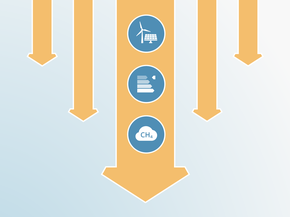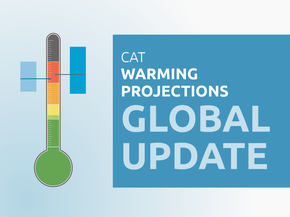Targets
Target Overview
Chile’s submitted its updated 2020 NDC to the UNFCCC in April 2020 (Gobierno de Chile, 2020). It includes two 2030 emissions reduction targets: an absolute unconditional target of 95 MtCO2e or a budget of 1,100 MtCO2e (2020–2030) and an emissions reduction target of up to 45% net GHG emissions conditional on specific financial, markets, technological and political conditions. Under the Climate Change Framework Law in June 2020, this target is legally binding.
Chile also announced a net zero GHG target for 2050 which was enshrined in law in June 2022 with the passing of the Framework Law on Climate Change (Congreso Nacional de Chile, 2022).
The new NDC reaffirms Chile’s 2030 target of an emissions level of 95 MtCO2e by 2030 but makes no reference to the conditional target that was previously included in the 2020 update. Since Chile’s 2035 NDC also does not include a conditional target, we assume that this target is no longer being considered by the government.
Chile submitted its 2035 NDC in September 2025. It targets an absolute emissions level of 90 MtCO2e and a budget of 480 MtCO2e for the 2031–2035 period (Gobierno de Chile, 2025). Chile’s 2035 NDC does not include a conditional target, nor does it reference the previous 45% emission reduction component from its updated 2030 NDC.
While Chile a submitted target that leads to lower emissions in 2035 compared to 2030, it is not reducing emissions fast enough and the gap between those targets and a 1.5°C aligned pathway compared to its fair share, has actually doubled – from 10 MtCO2e in 2030 to 22 MtCO2e in 2035 – signalling a weakening, not strengthening, of ambition. Our analysis of Chile’s 2035 NDC can be found here.
| CHILE — Main climate targets |
|---|
| 2030 NDC target | |||
|---|---|---|---|
| Formulation of target in NDC | Chile commits to a GHG emission budget not exceeding 1,100 MtCO2e between 2020 and 2030, with a GHG emissions maximum (peak) by 2025, and a GHG emissions level of 95 MtCO2e by 2030. | ||
|
Absolute emissions level in 2030 excl. LULUCF |
95 MtCO2e [7% above 2010] |
||
| Status | Submitted in April 2020 | ||
| 2035 NDC target | |||
|---|---|---|---|
| Formulation of target in NDC | Additionally, Chile commits to a GHG emission budget not exceeding 480 MtCO2e between 2031 and 2035, with a GHG emissions level of 95 MtCO2e by 2030. | ||
|
Absolute emissions level in 2030 excl. LULUCF |
90 MtCO2e to 95 MtCO2e [2% above 2010] |
||
| Status | Submitted in September 2025 | ||
| Net zero & other long-term targets | |||
|---|---|---|---|
| Formulation of target | Mitigation Goal: By the year 2050 at the latest neutrality of greenhouse gas emissions shall be achieved. | ||
|
Absolute emissions level in 2050 excl. LULUCF |
65 MtCO2e [27% below 2010 levels] |
||
| Status | Submitted in June 2022 | ||
NDC updates
On 9 April 2020, the Chilean government officially submitted its updated 2030 NDC (Gobierno de Chile, 2020), which is more ambitious than its first NDC submitted to the UNFCCC in 2017 and also slightly more ambitious than an earlier 2019 draft NDC. We rate Chile’s 2030 NDC target against both modelled domestic pathways and its fair-share contributions as “Almost sufficient”. While Chile’s target is strong, it would need to be improved if Chile aims to become compatible with the Paris Agreement’s 1.5° limit.
According to our calculations, by implementing all its current policies, Chile has already peaked its emissions ahead of the proposed peak year of 2025 ─ a notable achievement which positions the country a frontrunner in climate action. The GHG emissions budget between 2020 and 2030 would also be in line with the budget of 1,100 MtCO2e presented in the 2020 NDC, though further reductions would still be needed to meet the single-year 2030 target.
The updated 2030 NDC, submitted in 2020, is stronger in a few ways:
- It has a target of 95 MtCO2e in 2030, which is 2 MtCO2e lower than the 2019 draft NDC and significantly lower than the emissions that would have resulted from the 2017 unconditional target (131 MtCO2e).
- It includes an updated goal to peak GHG emissions by 2025, two years earlier than the previous draft.
- It includes an updated GHG emissions budget to 2030, which is smaller than the original draft.
The 2030 NDC also includes the following three targets for the LULUCF sector:
- Sustainable management and recovery of 200,000 hectares of native forest, equivalent to GHG emissions capture between 0.9 and 1.2 MtCO2e/year by 2030.
- Reforestation of 200,000 hectares of forest, from which at least half correspond to permanent forest coverage, from which at least 70,000 hectares should be native species. This is equivalent to GHG emissions capture of 3–3.4 MtCO2e/year by 2030.
- Reduce emissions from deforestation and land degradation of native forest by 25% by 2030 compared to average emissions between 2001–2013.
| CHILE — History of NDC updates | First NDC (2017) | NDC update (2020) |
|---|---|---|
| 1.5°C compatible |
|
|
| Stronger target | N/A |
|
| Economy-wide coverage |
|
|
| Fixed/absolute target |
|
|
| CHILE | First NDC (2017) | NDC update (2020) |
|---|---|---|
| Formulation of target in NDC |
Unconditional target: 30% below 2007 GHG intensity of GDP by 2030. Conditional target: 30–45% below 2007 intensity of GDP. |
Unconditional target: GHG emission budget not exceeding 1,100 MtCO2e between 2020 and 2030, with a GHG emissions maximum (peak) by 2025, and a GHG emissions level of 95 MtCO2e by 2030. Conditional target: Up to 45% reduction in net GHG emissions by 2030 from 2016 levels |
|
Absolute emissions level excl. LULUCF |
Unconditional target: 131 MtCO2e by 2030 Conditional target: 103–122 MtCO2e by 2030 |
Unconditional target: 95 MtCO2e by 2030 Conditional target: 88–95 MtCO2e by 2030 |
|
Emissions compared to 1990 and 2010 excl. LULUCF |
Unconditional target: 48% above 2010 emissions by 2030 Conditional target: 16%–38% above 2010 emissions by 2030 |
Unconditional target: 7% above 2010 emissions by 2030 Conditional target: 0.6%–7% above 2010 emissions by 2030 |
| CAT rating |
Overall rating*: Highly Insufficient |
Conditional target against modelled domestic pathways: Almost Sufficient Unconditional target against fair share: Almost Sufficient |
| Sector coverage | Economy-wide, excl. LULUCF | Unchanged |
| Separate target for LULUCF |
Yes Separate target from rest of emissions: management and recovery of 100.000 hectares and reforestation of 100,000 hectares of forest by 2030. |
Yes Separate target from rest of emissions: management and recovery of 200,000 hectares by 2030, reforestation of 200,000 hectares of forest by 2030, and reducing emissions from deforestation and land degradation by 25% by 2030 from the 2001-2013 emissions average . |
| Gas coverage | All greenhouse gases | All greenhouse gases and separate black carbon target |
| Target type | Emissions intensity of GDP |
• Absolute emissions limit • Absolute emissions reduction budget • Emissions peak |
| Explanation why the target is a fair contribution towards the global goal | Not applicable | Chile argues it is a progression of efforts, peaking and climate neutrality in line with global targets. |
| Followed guidance in Decision 4/CMA.1 on target transparency | Not applicable | Chile has provided the guidance but has not presented the information in a tabular form. |
Target development timeline & previous CAT analysis
- 16.10.2019 “Chile submitted a draft NDC update in 2019”
- 09.04.2020 “Chile submitted an NDC update”
CAT rating of targets
The CAT rates NDC targets against each country’s fair share contribution to global climate change mitigation, considering a range of equity principles including responsibility, capability, and equality. The CAT also rates NDC targets against indicative national emissions from global least-cost emission pathways ("modelled domestic pathways"). Most developing countries may need support to achieve emissions reductions in line with their share of a global least-cost pathway to achieving the 1.5°C long-term temperature goal.
Chile does not specify a conditional target or an international element in its NDC, so we rate Chile’s target against the two rating frameworks.
We rate Chile’s 2030 NDC target as “Almost sufficient” when compared with modelled domestic emissions pathways. This rating indicates that Chile’s 2030 target is not yet consistent with modelled domestic pathways limiting warming to 1.5°C but could be, with moderate improvements.
If all countries were to follow Chile’s approach, warming could be held below—but not well below—2°C. To improve its rating and be consistent with the 1.5°C temperature limit.
Whether Chile should receive climate finance from abroad to reduce its emissions is a matter of debate. Our methods do not provide a clear answer to this question. On balance, the CAT’s methodology shows that a small amount of international support is consistent with the wide range of literature on fair share contributions to meeting the Paris Agreement’s goals. However, this contribution would likely be small under most equity perspectives.
Chile could increase the ambition of its conditional 2030 climate target equivalent to an absolute emissions limit of 79 MtCO2e excl. LULUCF in 2030 and communicate the finance needs that it would need to achieve it.
The 2020 NDC links the 2030 target to Chile’s long-term goal for GHG neutrality by 2050, as well as to planning processes involving governance and existing and future strategies, including the “Long-term Climate Strategy 2050.” According to the NDC text, the current NDC planning and update process should allow for the NDC and its consecutive iterations to be intermediate milestones to achieve the 2050 neutrality goal, i.e. taking into account the necessary measures to reach the goal (Gobierno de Chile, 2020).
It also includes a target to reduce black carbon emissions by at least 25% by 2030 below 2016 emission levels.
Black Carbon and Chile’s NDC
Chile’s 2020 NDC update includes a target to reduce black carbon emissions, which has substantial co-benefits for human health. However, reductions in black carbon are generally not additional to reductions in CO2, because large fractions of black carbon emissions stem from the same emission sources as CO2. Emission reduction policies therefore often reduce CO2 and black carbon simultaneously, and this is already included in calculations of the emissions reductions required to hold warming well below 2°C globally, like the “emissions gap” and “fair share” reductions (see section on Fair Share).
In its Sixth Assessment Report (AR6), the IPCC does not provide calculations of Global Warming Potential for black carbon comparable to those provided for greenhouse gases. The report indicates a net-positive effect on warming of black carbon over time and concludes that reducing black carbon emissions in the short-term would contribute to limiting temperature increase to 1.5°C.
For information on Chile’s 2019 draft NDC or its original submission in 2017, see our comparison assessment of Chile’s NDCs and the previous country assessment of the 2017 NDC submission.
We rate Chile’s 2030 NDC target as “Almost sufficient ” when compared to its fair-share contribution to climate action. The “Almost sufficient ” rating indicates that Chile’s target in 2030 is not yet consistent with its fair share of the global mitigation effort to limit warming to 1.5°C but could be, with moderate improvements. Chile’s target is within the range of what is considered to be a fair global effort, but would require other countries to make deeper reductions and comparably greater effort to limit warming to 1.5°C. If all countries were to follow Chile’s approach, warming could be held below—but not well below—2°C.
The 2030 NDC target to be achieved with own resources needs to be improved to align with the 1.5°C limit, regardless of international support. To improve its rating and be consistent with the 1.5°C temperature limit under fair share, Chile could set an absolute emissions limit of 85 MtCO2e excl. LULUCF.
Net zero and other long-term target(s)
Chile announced its net zero target for 2050 as proposed legislation in the Framework Law on Climate Change in 2020 (President of Chile, 2020) and included it in the updated NDC submitted to the UNFCCC in the same year (Gobierno de Chile, 2020). In November 2021, the target was also included in the LTS and, since June 2022, it is enshrined in law with the passing of the Framework Law on Climate Change (Congreso Nacional de Chile, 2022).
Chile’s net zero target covers most key elements. It covers all sectors and gases, communicates strategic goals and emissions targets per sector, and provides a detailed methodological framework. Notably, Chile underpins these sector-specific ambitions with detailed emissions pathway analyses and budgets. While Chile does not actively outline any plans to rely on reductions and removals outside its borders, future iterations of its NDC could explicitly rule out international credits.
Chile could further improve its net zero target by considering good practice standards for a few elements. It could include international aviation and shipping in its target’s scope, and explicitly elaborate on fairness considerations.
For the full analysis click here.
Further analysis
Latest publications
Stay informed
Subscribe to our newsletter




